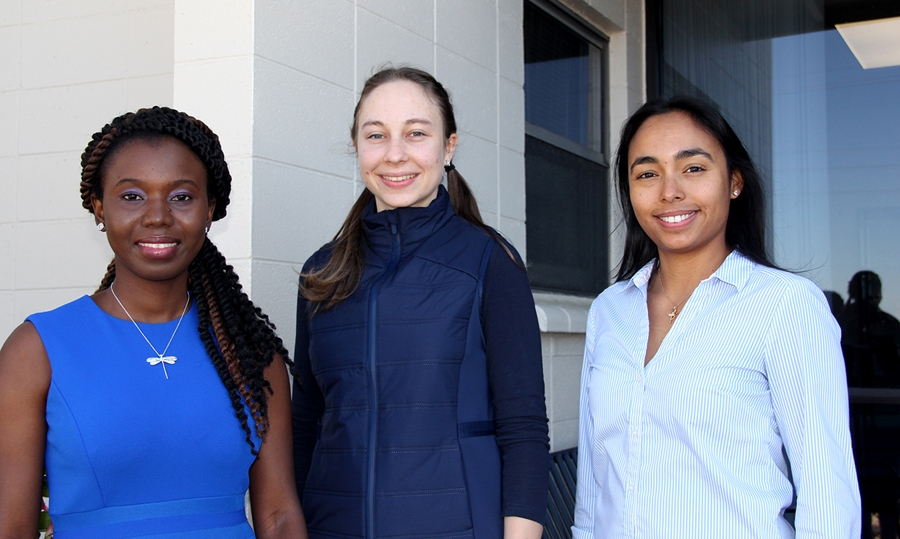
FAYETTEVILLE, Ark. – Annagret Jannasch and Rebecca Bruce, who are conducting rice research in U of A's Dale Bumpers College of Agricultural, Food and Life Sciences, recently finished first and second in a video contest while Ana Gonzalez won first place in a presentation category.
All three are food science doctoral students and competed in the Cereals & Grains Association virtual annual meeting student competition.
Jannasch and Gonzalez both work under the direction of Ya-Jane Wang, professor of carbohydrate chemistry, and Bruce under the guidance of Griffiths Atungulu, associate professor of food processing and post-harvest system engineering. Wang and Atungulu are members of the faculty, as well as researchers and scientists with the Arkansas Agricultural Experiment Station, the research arm of the U of A System Division of Agriculture.
Jannasch's three-minute video presentation was "Limited-Water Parboiling: A Novel and Sustainable Method to Fortify Rice." Bruce's four-minute video was "Microwave Drying of Rice."
Their videos can be viewed here.
Micronutrient deficiency disorders are common in predominantly rice-consuming countries, especially South Asia. Fortifying rice through parboiling has shown to increase retention rate of nutrients while maintaining acceptable sensory characteristics, but the conventional soaking step in the process generates large amounts of nutrient-rich wastewater. Without treatment, the wastewater can lead to nutrient overload in soil. Jannasch developed and evaluated a limited-water soaking method to fortify rice with minerals and vitamins.
"The results showed that the limited-water soaking method reduced the amount of effluent by 89 percent and the amount of total solids in wastewater by up to 85 percent, on average, while the uptake of the nutrients were comparable or only slightly lower than the conventional excess-water soaking method," said Wang. "Therefore, the limited-water soaking method can reduce the cost of fortification and wastewater treatment without affecting rice quality attributes."
Bruce's study is part of a USDA-NIFA funded Small Business Innovation Research project with the scope of engineering alternative energy-efficient rice drying systems.
"Rebecca is developing a novel, energy-efficient, material state-gradient controlled, single-pass, 915 MHz microwave-assisted drying technology for freshly-harvested and parboiled rice to improve energy use, recovery of head rice and preserve overall rice quality," said Atungulu. "The conventional heated-air rice drying process requires elaborate drying infrastructure and space footprint, uses fossil fuel, which significantly contributes to greenhouse gas emissions, and cannot complete drying parboiled or freshly-harvested, non-parboiled rice to safe storage moisture content in a single pass. The more the drying passes and tempering stages used, the larger the drying energy input and longer the drying duration within the constraints of limited rice drying capacity and typical short rice-harvesting 'window.' Rebecca's research is critical to identify alternative energy-efficient drying technology that can help recover higher head rice yields and preserve rice quality."
Gonzalez won the Best Student Research Presentation Award sponsored by Megazyme Ltd. in the Carbohydrates Division. Her research is "Surface Removal Enhanced the Formation of a Porous Structure in Potato Starch."
Porous starches are attracting attention from both food and pharmaceutical industries because their adsorption ability can protect bioactive components sensitive to processing and storage conditions. Porous starches are commercially prepared by digestion of cereal starches with amylases, but not potato starch. The limited amylolytic digestion of potato starch is attributed to its absence of surface pores, granules and crystalline structure. Gonzalez's study investigated the impact of granule surface on potato starch susceptibility to amylases. After the combination of surface removal and digestion by amylases, a more defined porous structure was observed in potato starch, which may enhance the degree of binding and hydrolytic activity amylases.
The Cereals & Grains Association Cereals & Grains Association is a global, nonprofit association of nearly 2,000 scientists and food industry professionals working to advance the understanding and knowledge of cereal grain science and its product development applications through research, leadership, education, superior technical service and advocacy. Its goal is to be the global authority in cereal grain science and technology.
About the Dale Bumpers College of Agricultural, Food and Life Sciences: Bumpers College provides life-changing opportunities to position and prepare graduates who will be leaders in the businesses associated with foods, family, the environment, agriculture, sustainability and human quality of life; and who will be first-choice candidates of employers looking for leaders, innovators, policy makers and entrepreneurs. The college is named for Dale Bumpers, former Arkansas governor and longtime U.S. senator who made the state prominent in national and international agriculture. For more information about Bumpers College, visit our website, and follow us on Twitter at @BumpersCollege and Instagram at BumpersCollege.
About the University of Arkansas: The University of Arkansas provides an internationally competitive education for undergraduate and graduate students in more than 200 academic programs. The university contributes new knowledge, economic development, basic and applied research, and creative activity while also providing service to academic and professional disciplines. The Carnegie Foundation classifies the University of Arkansas among only 3 percent of colleges and universities in America that have the highest level of research activity. U.S. News & World Report ranks the University of Arkansas among its top American public research universities. Founded in 1871, the University of Arkansas comprises 10 colleges and schools and maintains a low student-to-faculty ratio that promotes personal attention and close mentoring.
Topics
Contacts
Robby Edwards, director of communications
Dale Bumpers College of Agricultural, Food and Life Sciences
479-575-4625, robbye@uark.edu